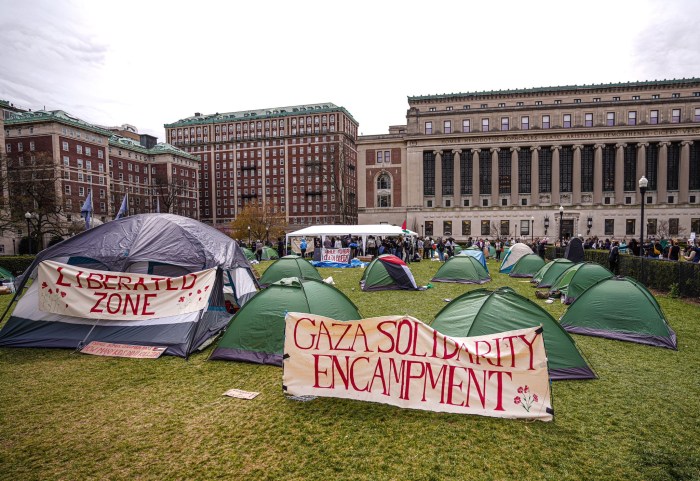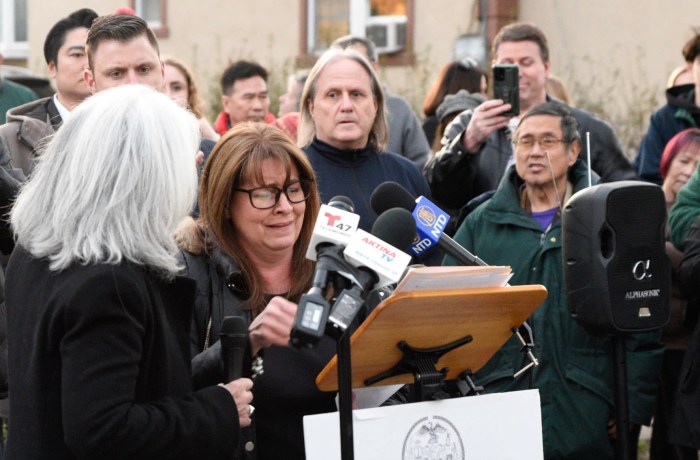BY SCOTT STIFFLER | Public meetings are taking place, phone surveys are being conducted and coalitions are being formed — as Jamestown Properties’ plan to vertically expand Chelsea Market draws closer to its ultimate approval or rejection.
On January 25, the Community Board 4 (CB4) Chelsea Preservation and Planning Committee (CP&P) held what CB4 chair Corey Johnson described as “the first of at least three times we will look at the Chelsea Market proposal before the full board meeting.”
Both the full board and CP&P are currently awaiting approval of Jamestown’s application — which will come in the form of ULURP (Uniform Land Use Review Procedure) certification. Once the Department of City Planning (DCP) delivers certification to CB4, the full board will have 60 days to issue its own purely advisory recommendation — which will be influenced by a CP&P position taken at its earliest opportunity once the DCP delivers certification.
With another CP&P meeting set for February 23, Johnson noted that the public may have at least one, possibly two, more opportunities to express their opinions and concerns via a two-minute turn at the microphone. Their final chance to weigh in would likely take place at CB4’s April 4 or May 2 full board meeting.
Johnson also noted that after CB4 takes a position, the process will continue over the next six to nine months — as the Borough President and the City Planning Commission weigh in before the City Council reaches a decision that’s subject only to mayoral override.
In a February 7 phone interview, Johnson said that since Chelsea Market is in the district of City Council Speaker Christine Quinn, “She will have the most say on what happens at the site. It’s our hope that she gives serious weight and consideration to the community board’s recommendation.” Asked if CB4 has received any indication of the Speaker’s intentions, Johnson said, “What we’ve been told is that the Speaker hasn’t taken a position on this, and that she’s waiting to see what the certified application looks like. We have been in talks with her staff, though.”
Necessarily cautious at this point in the process, Quinn is nonetheless among the ever-shrinking circle of those who’ve yet to express a public opinion on the contentious matter of permitting Jamestown Properties to add office space and a business hotel to the existing Chelsea Market structure.
Not among the bashful were approximately 100 members of the public, who attended the January 25 CP&P meeting — held at Fulton Center (Ninth Avenue, between 17th and 18th Streets).
During his introductory remarks, Johnson traced the possibility of expanding Chelsea Market from a general discussion first brought to CB4 in 2007 to the present Jamestown proposal.
CP&P co-chairs Lee Compton and Brett Firfer spoke for the next ten minutes — providing a historical context to the current debate by recalling the purpose, physical scope and philosophical intent of the Special West Chelsea District. The District, Compton noted, functions as a plan, guide and statement “of what the city would like an area to become, and a set of tools [such as regulating building usage and height] to realize that goal.”
Compton directed members of the public to the CB4 website (nyc.gov/mcb4), where the Environmental Assessment Statement, the ULURP draft application and a PowerPoint Presentation from Chelsea Market can be accessed from the home page. He encouraged those unable to attend public meetings to send an email to CB4 Community Associate Nelly Gonzalez (negonzalez@cb.nyc.gov) — who will place those comments in a file for the committee’s review.
CB4 District Manager Robert J. Benfatto, Jr. then provided a review of issues and concerns — among them, an increase in noise and traffic, shadows on the High Line and compatibility of the design’s façade and setbacks with surrounding structures.
Benfatto also cited requests from the community for open space on the roof of the 10th Avenue building (if it gets built) and the possible establishment of an affordable housing fund. These requests, he noted, could offset dissatisfaction with Jamestown’s $17 million donation to the High Line. “Primary users of the High Line are not residents,” Benfatto said — in the first of several jabs taken at the elevated park (which is experiencing some backlash for the financial windfall it stands to receive from Jamestown).
Over two dozen people spoke during the 60 minutes allotted for public comment. Only one (Peter Muller, Friends of the High Line’s director of planning and design) expressed a favorable opinion of the Jamestown proposal. “We hope a solution can be achieved,” he noted, while reaffirming, “Friends of the High Line is supportive of this proposal.” The remaining speakers used their two minutes to articulate variations on a handful of common themes.
Andrew Berman, director of the Greenwich Village Society for Historic Preservation, called the latest design renderings, “two huge, enormous additions,” that are, “just plain wrong.” Friends of 20th Street Park president Matt Weiss cited the three thousand signatures gathered by his organization as proof that, “There is a pressing need for open space in our district in the face of overdevelopment.”
Bob Trentlyon (seen recently around town encouraging preparation for worst case storm surge scenarios) thanked Mitt Romney for teaching him how a venture capital firm works. “Now I can understand it,” said Trentlyon, with comic timing and much irony. “While the pension funds that invest with Jamestown can make 16 or 17 percent annually, Jamestown management may make ten times as much. They make that by buying, building up and selling properties at a huge profit.”
In a February 6 phone conversation with Chelsea Now, Greenwich Village-Chelsea Chamber of Commerce (GVCCC) executive director Tom Gray spoke about his organization’s decision to publicly support the Chelsea Market expansion (first announced in a January 27 newsletter sent to GVCCC members and email subscribers). Gray said that moving forward, his organization would have a more vocal and visible role in the public debate. “It’s hard to get them out to community board meetings,” said Gray when asked why there were no members present to speak at the January 25 CP&P meeting. “It’s especially difficult for them [small business owners] to leave their businesses.” Gray noted that when members cannot be at such public forums, “We at least give them a letter to enter into the public record.”
As for their current public position, Gray says, “Chelsea Market is obviously very important to the economy of the city. There’s a lot of great organizations [in the area]: The Food Network, Google, Major League Baseball. They need to grow, and we want them to grow in Chelsea. We also want to attract new business. It makes total sense, from the Chamber’s perspective. This area is growing, and I guess it’s a good problem to have.”
GVCCC is among several organizations that have recently come together to form The Chelsea Market Coalition. Lee Silberstein, executive vice president of The Marino Organization (representing Jamestown Properties), spoke with Chelsea Now on February 7 regarding the formation of the coalition.
Announced to the public in a January 24 press release sent by The Marino Organization, it’s described as “a coalition, consisting of neighborhood organizations, leading real estate, business and labor union organizations,” that will “aggressively advocate for approval of the Market’s expansion as the City’s Uniform Land Use Review Process (ULURP) commences. Currently, members include the Manhattan Chamber of Commerce, GVCCC and the Real Estate Board of New York. The Building and Construction Trades Council of Greater New York threw its support behind the Coalition upon receiving confirmation that the project would be “built using unionized construction.”
In addition to these organizations, Silberstein notes the Coalition’s membership includes, “frankly, a lot of folks who are just people who live or work in the area and know of Chelsea Market.” He puts the number of unaffiliated at a few dozen, and speculates that after ULURP certification, “I am sure that members of the Coalition will be turning out at those hearings to let their support be known.”
Support for Chelsea Market is also being sussed out through a phone survey, which came to our attention through a February 1 email sent by Paul Groncki. A Ph.D economist who worked in market research for 20 years (and is currently chair of the 100 West 16th Street Block Association and treasurer of Save Chelsea), Groncki declared the 20-minute survey to be “fairly unbalanced” — noting, “You will have lots of opportunities to express your opinions about the development, Jamestown, Save Chelsea and our elected officials (and how their position on Jamestown will affect your support for them).”
In a February 7 phone conversation with Chelsea Now, Groncki said that since his email message, “I’ve talked to a few other people who actually took the survey. Those who stick it out say it’s a fair survey, and they got to express their opinions.”
Asked if he or any of the others were made aware of who paid for the survey, Groncki recalled, “About halfway through, I was concerned it was just the Jamestown people who were doing it — because the questions were so focused on Chelsea Market. But then they shifted to other players in the community, and it took just as long to do that.” Many of those questions involved scales to assess how aware participants were of Fulton Youth and Save Chelsea — as well as the relative importance of a mayoral candidate’s opinion on the Chelsea Market expansion.
Asked if the survey was being paid for by Jamestown and/or The Chelsea Market Coalition, Silberstein would only say, “The Coalition and Jamestown aren’t prepared to talk about specific tactics yet. We will have more to say when we’re ready.”
Johnson was, by comparison, fairly transparent when asked to tip his hand as to how CB4 is leaning. “There’s pretty strong consensus at the board level that we are steadfast in our opposition to a hotel on Ninth Avenue,” he said. “We also continue to have real qualms with the bulk and design of the Tenth Avenue-facing building.”

















